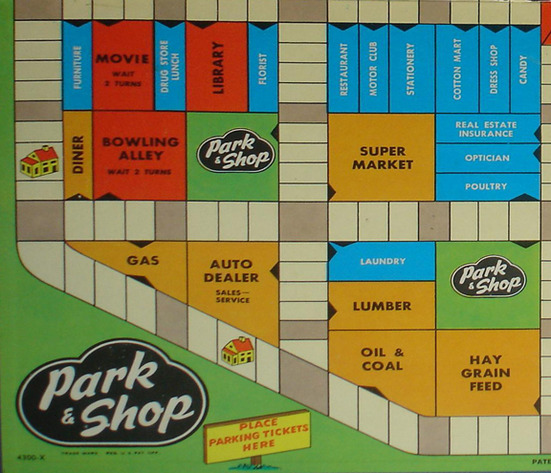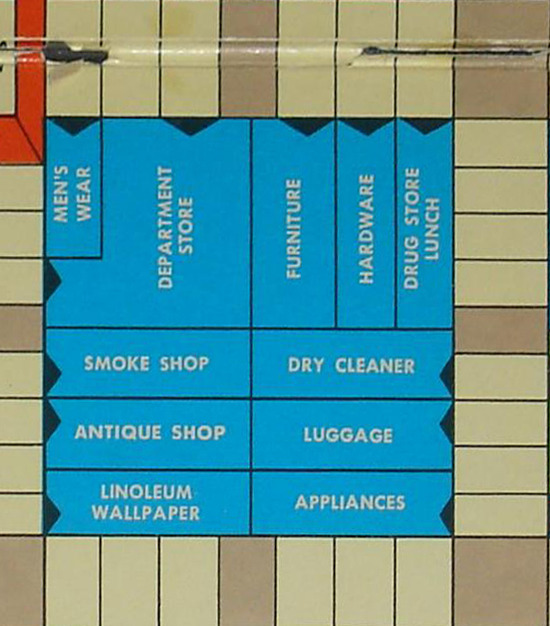Park & Shop
 Just by chance, a post on another blog caught my eye a few weeks back and brought back memories long since forgotten of a simple board game that, when I was a child, seemed magical and inspiring.
Just by chance, a post on another blog caught my eye a few weeks back and brought back memories long since forgotten of a simple board game that, when I was a child, seemed magical and inspiring.
It was a Milton Bradley game called Park & Shop. There were a couple of different versions, and the one I had came out sometime in the 1960s. The board was a decidedly un-modern (now) city, in which every shopping need could be met in a few nicely arranged city blocks. In a way, it was the simplest of games: You got a tiddlywink, a plastic car, and a plastic man. Put your tiddlywink on one of the homes on the board – that was now your home. Pull a card, which would tell you where you needed to go to shop: furs, shoe repair, drug store. Roll the dice and move your car along the street spaces, trying to reach your destination. Along the way, you might get a parking ticket, which would give you another destination: “Pick up a sack of chicken feed while you have the car. Drive to hay, grain and feed.”
Once you got to your destination, you would put your plastic man in the store and roll the dice for what you had to pay. I don’t remember how many destinations you had to get to, or how you won in the end, and it never really mattered. The fun of the play was that it was amazingly like real life at the time, like a fun little trip around the city with Mom. I played this game for, oh, a million hours when I was a kid. Sometimes with my mom, sometimes with my aunt, sometimes even with other kids.
And it was a city that had everything, but cities did back then. There was a hay, grain and feed and a lumber yard, an auto dealer, a coal yard. There was a bowling alley, a newspaper and, that most downtown of downtown stores, the nut shop. There was a linoleum and wallpaper shop, a smoke shop, a 5&10, and a fish market. This city had everything, all just blocks from your home. There were, of course, multiples of some things, like diners and gas stations, which could affect how far you had to travel to meet your next objective. And for every store on the board, I could picture a real store in my mind. I knew the hardware store, the luggage store, the poultry shop. I knew the smell of the smoke shop from the street, the bare bulbs strung along the auto dealer’s lot, the sound of the drug store lunch counter. Playing the game was just like a trip downtown.
 Coolest of all, to my child’s mind, were the stores with two entrances. Unthinkable in the big box era, it was much more common then for a store to have a back entrance which often opened onto a side street or alley. (Our A&P had four or five registers at the front door, and two more by the back door – though the back registers didn’t have grinders for the 8 O’Clock Coffee.) Inexplicably, there always seemed to be something special, perhaps familiar, about using the back entrance – it seemed to say, “We come here all the time.” And this board captured that, with a stores that could be entered from different streets. And, if it helped you in the game, you could go out the other entrance, skipping several spaces. To me, this seemed unspeakably real.
Coolest of all, to my child’s mind, were the stores with two entrances. Unthinkable in the big box era, it was much more common then for a store to have a back entrance which often opened onto a side street or alley. (Our A&P had four or five registers at the front door, and two more by the back door – though the back registers didn’t have grinders for the 8 O’Clock Coffee.) Inexplicably, there always seemed to be something special, perhaps familiar, about using the back entrance – it seemed to say, “We come here all the time.” And this board captured that, with a stores that could be entered from different streets. And, if it helped you in the game, you could go out the other entrance, skipping several spaces. To me, this seemed unspeakably real.
Props to Anne Chudobiak for this post that jogged my memory and expressed a similar love of the game, and to Board Game Geek for filling in the blanks.
What set this all off? These enchanting paintings of board game boxes by Tim Liddy. Click on “Present Work” to set off all kinds of memories.
